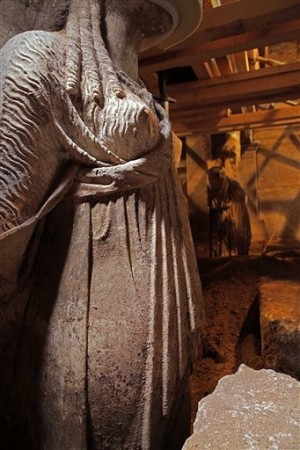Ancient Greek tomb dig finds marble statues

This photo released on Thursday, Sept. 11, 2014 by the Greek Culture Ministry shows two approximately life-sized female statues on a wall leading to a yet unexplored inner room of a huge underground ancient tomb, in Amphipolis, northern Greece. The tomb dates between 325 B.C. — two years before the death of ancient Greek warrior-king Alexander the Great — and 300 B.C. Archaeologists have also discovered two large marble sphinxes on the facade of the barrel-vaulted tomb, which was originally topped by a marble lion on a high plinth. It is not yet known who the tomb was built for, although Alexander himself was buried in Egypt. (AP Photo/Culture Ministry)
ATHENS, Greece—Archaeologists inching through a large 2,300-year-old tomb in northern Greece on Thursday uncovered two marble female statues flanking the entrance to one of three underground chambers, in another sign of the unusual attention and expense lavished on the unknown person buried there.
The dig has gripped the public imagination amid non-stop media coverage, which Greek archaeologists say is placing an unfair burden on the excavation team.
A Culture Ministry statement said the statues show “exceptional artistic quality.” Their upper sections were discovered last week, but their bodies — clad in semi-transparent robes — emerged after part of a blocking wall was removed.
Less than half the tomb, which bears signs of having been plundered in antiquity, has been explored, and removing the tons of earth that fill it will take weeks. Although no burials have been found so far, the opulence points to some senior official linked with ancient Greek warrior-king Alexander the Great.
The barrel-vaulted tomb is among the biggest of its period in antiquities-rich Greece. Excavator Katerina Peristeri believes the mound was originally topped by a stone lion on a large plinth, found a few kilometers away 100 years ago, that was probably removed during Roman times. She has also voiced strong hopes that the site hasn’t been looted.
Article continues after this advertisementArchaeologist Chryssoula Paliadelli, who is not involved in the excavation, told The Associated Press that the tomb has several exceptional features, including a monumental facade that leaves the top of the vault exposed above two large marble sphinxes.
Article continues after this advertisementThe excavation, on a hillock near ancient Amphipolis, 600 kilometers (370 miles) north of Athens, has dominated local news coverage for a month, since Prime Minister Antonis Samaras visited it and pre-empted archaeologists by releasing details on the findings.
A media blitz followed amid speculation that the tomb may contain buried treasure and the remains of an eminent figure — although Alexander himself was buried in Egypt. Dozens of tourists daily try to get a peek of the fenced-off site, and visitor numbers at the nearby Amphipolis museum have swelled.
Peristeri has dated the tomb to between 325 BC and 300 BC. Alexander conquered a vast area from modern Greece to India, enriching many of his close friends and commanders. His death in 323 B.C. was followed by upheaval as his generals fought over the empire.
Paliadelli, a professor at the University of Thessaloniki, said the media attention is greater than during the discovery in the late 1970s, in which she participated, of a rich unplundered tomb identified as that of Alexander’s father, King Philip II of Macedonia in a royal cemetery 200 kilometers (125 miles) to the west.
“The media — television, the Internet — has developed so much,” she said. “We worked at a much calmer pace, despite the pressure from the nature of the finds — that included wood and leather artefacts that required urgent conservation.”
The Association of Greek Archaeologists on Thursday criticized the Culture Ministry’s approach to the media, which it said was tailored to “satisfying a public opinion hooked on facile sensationalism and over-consumption of television, print and online sub-products.”
The site, set among almond groves and tobacco fields, has about 20 police providing a 24-hour guard to deter looters, who have plagued the area in the past.
Former antiquities guard Alekos Kochliaridis told the AP that robbers tried to excavate the mound in 1952, brazenly turning up in broad daylight with a mechanical digger.
“We local residents called the police and they chased them off,” he said. “The whole surrounding area has plenty of holes left by illegal excavations.”